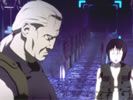Eye For Film >> Movies >> Ghost In The Shell 2: Innocence (2004) Film Review
Mamoru Oshii's Ghost In The Shell (1995), based very loosely on a manga of the same name by Shirow Masamune, was to become one of Japan's most successful feature anime exports of all time. Its blending of stylised fight sequences and humanist philosophy in a dystopian cyberpunk setting made it one of the most important influences on, amongst other things, the Wachowski Brothers' The Matrix (1999). Even today, Ghost In The Shell stands up to the competition - until, that is, it is set alongside its next generation sequel, Ghost In The Shell 2: Innocence, which, though scrupulously backwards-compatible with the original, makes it, and everything else besides, seem entirely redundant.
Dead-eyed, dog loving Batou is back, a once human detective, now so thoroughly mechanised and technologically enhanced that it is no longer clear what he is - man, superman, god, animal, robot, or doll. He is assigned with his new, mostly human partner Togusa to determine why the Hadaly series of female sex droids have been turning on their users and going on murderous rampages. The investigation leads Batou on his own murderous rampage against a gang of yakuza, before having his mind messed with by a mischievous hacker and, finally, being reunited with his disembodied ex-partner Major Motoko, deep under the ocean where the horrific truth behind the dolls' behavior is discovered to be all too human.

GITS 2: Innocence is only the sixth animated film to have been in competition at Cannes and the first ever to have been selected to contend for the coveted Palme d'Or - and it is not difficult to see why it has been accorded such privilege. Put simply, few animated features have ever looked so good and fewer still have been underpinned by such probing intelligence.
Recent efforts, such as Sky Blue (2004) and Appleseed (2004), have certainly offered a similar blend of hand drawn and computer generated animation. Unfortunately, both those films were lumbered with adolescent scripts that could not match the nuanced texture of their visual palette. Only in Appleseed, also adapted from a Masamune manga, did the placement of hand drawn 2D characters into exquisitely rendered photo realistic 3D backgrounds have a symbolic function that went beyond the mere power to provide cutting-edge eye candy. In GITS 2: Innocence, too, the hybrid imagery provides a strong visual cue to the film's principal theme: the shifting place of humanity in a world dominated by technology.
This sequel, however, shifts from the action-oriented scenario of the original to more brooding, noirish terrains and sets its characters on a quest to investigate, not only a mysterious crime, but also the very nature of the human soul. This is the existential moodiness of Blade Runner, only set in the age of the World Wide Web, and with the occasional hard violence consistently outnumbered and outgunned by even harder metaphysics. As Batou so succinctly puts it, "Poetics now? We're running out of ammo."
In what must qualify as one of the most literate screenplays ever to accompany animation, the main characters quote liberally from sources like Descartes, Milton and the Old Testament as they try to work out whether there is even a glimmer of individual life left in them, or whether they have become mere cogs in a satanic machine. Their angst-riddled struggle to uncover the merest ghost of humanity in otherwise entirely artificial shells - whether the life-like replicants that surround them, or their own super-modified bodies - lends their experiences a philosophical depth that transcends genre.
If this sounds like too hard a pill for your typical western fanboy of anime to swallow, then it is helped down by the intricately beautiful visuals, while more adult viewers will see that the mind-blowing story and its reality-bending aesthetic form a sublime continuum, where the medium becomes part of the message. Either way, this is animation at its most acute and enthralling.
Reviewed on: 28 Oct 2005


















